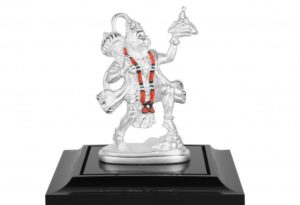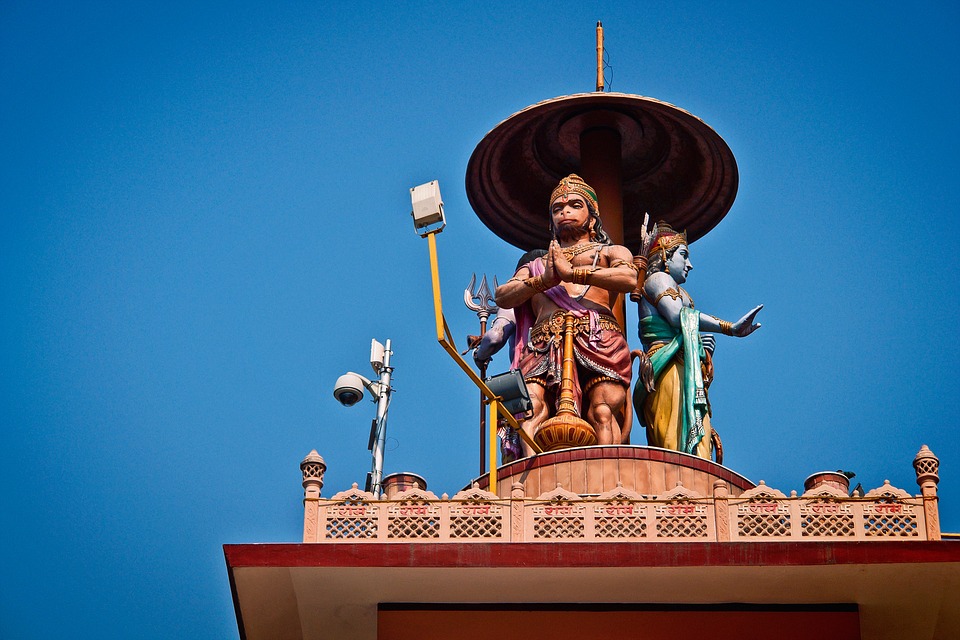In Indian religious philosophy, there are certain unique concepts not seen in other later religions. One of them is the utmost importance given to duty, referred to as ‘dharma’, while the other is the concept that god can arrive among humanity as a human being as an incarnation. Many of the popular deities are incarnations of the Lord, and their divinity is proved by their deeds and character. One of such deities is Lord Hanuman.
One of the most commonly worshipped deities in India, LORD HANUMAN was the friend and follower of Lord Rama who is considered the incarnation of ‘Vishnu‘. Hanuman, himself is considered an incarnation of ‘Rudra’ or ‘Shiv’, as he is considered to be representing the thirteenth character or form of Rudra. He is also referred to as the son of winds or PAWAN PUTRA, since mythological tales describe that the essence of Lord Shiva was carried to his mother, ANJANI, by the god of winds or PAWAN. Hence, he was born with mystical powers of flying in the air.
He is a central character in RAMAYANA, the ancient epic describing the life story of Lord Rama.
He is portrayed as a model friend and devotee. His selfless devotion to Rama is the subject of folklore and one of the reasons for his being so highly revered even to date. In Ramayana, Hanumana is depicted as VAN-NAR, a race of tribal living deep inside the forests. However, this word is also used for monkeys who live in the forest, and hence often there is confusion that Hanumana is also a monkey, and many times referred to as Monkey king in English scripture.
 In the story of Ramayana, Van-nar King Sugreeva deputes his soldiers to search for Sita, Rama’s wife who had been abducted by the king of Lanka, Ravana. When the soldiers reach the seashore, they find that Lanka was across the width of about 90 miles of sea and none of them were capable of crossing it and reaching Lanka. Finally, it was Hanumana who crossed the sea, entered Lanka, met Sita, gave her the message that King Rama was coming. Subsequently, he destroyed the garden where Sita was kept captive and killed the soldiers as well as AKSHAYA, the son of Ravana, who came to capture him. Then when Ravana’s son INDRAJIT attacked him with divine weapons, he surrendered in respect of those divine weapons. When he was taken to court, Ravana asked him to be punished by burning his tail. Instead, Hanuman escaped and put many parts of Lanka on fire.
In the story of Ramayana, Van-nar King Sugreeva deputes his soldiers to search for Sita, Rama’s wife who had been abducted by the king of Lanka, Ravana. When the soldiers reach the seashore, they find that Lanka was across the width of about 90 miles of sea and none of them were capable of crossing it and reaching Lanka. Finally, it was Hanumana who crossed the sea, entered Lanka, met Sita, gave her the message that King Rama was coming. Subsequently, he destroyed the garden where Sita was kept captive and killed the soldiers as well as AKSHAYA, the son of Ravana, who came to capture him. Then when Ravana’s son INDRAJIT attacked him with divine weapons, he surrendered in respect of those divine weapons. When he was taken to court, Ravana asked him to be punished by burning his tail. Instead, Hanuman escaped and put many parts of Lanka on fire.
When LAKSHMAN, Rama’s brother who lived with him during his fourteen years of exile, was shot by Indrajit, Lord Hanumana brought the SANJEEVANI herb from the Himalayas to treat him and save his life.
Lord Hanumana is considered the ideal example of selfness and devotion to the lord.
Another part of his personality and character is his extreme detachment with all material wealth and sensual pleasures. He was fully devoted to Lord Rama, in valor and power he was unchallenged, and he was absolutely free of greed, lust, and fear. Thus, he is considered an ideal example for young adults and students. His fearlessness is an inspiration for all and he is remembered by his devotees as a means of inspiration at all times.






